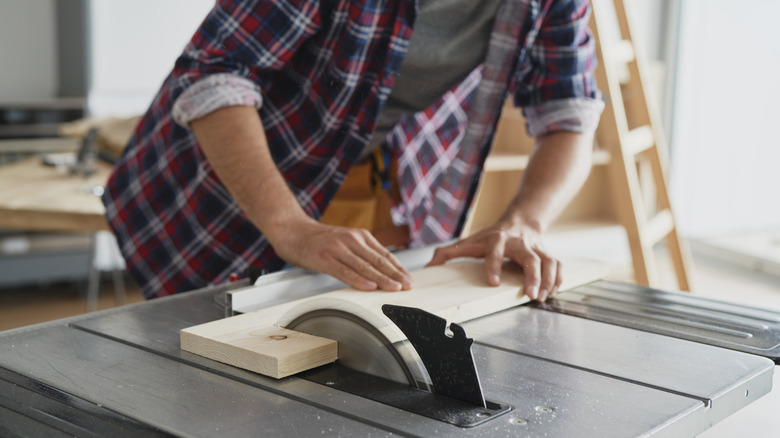Signs It May Be Time To Replace The Blades On Your Table Saw Tool
As any good table saw user knows, having sharp blades is the key to both good quality cuts and workshop safety. While the life expectancy of a table saw blade can vary based on how often it is used, how you use the tool, and how many times it has been sharpened, putting off a much-needed replacement is an option that should never be on the table. After all, a dull blade could quickly become a dangerous one. Instead of cleanly slicing through material, a dull blade often resists, creates excessive heat, and increases the risk of kickback and injury. Properly maintaining and replacing parts is one of many tips to help you safely use a table saw, and it's especially important when you're dealing with the business end of your equipment.
While it would be convenient to give an exact time frame for blade changes, the proper point to make the swap depends on several factors, like blade type and each blade's usage history. But whether you're a weekend hobbyist or a professional contractor, you should be prepared to replace the blade as its performance dips, you start to experience trouble feeding material into the blade, or you notice obvious signs of wear, like chips, cracks, warping, and rounded edges. Remember to keep safety in mind before beginning any blade change, like making sure the table saw is completely unplugged before you go anywhere near the blade assembly. We also recommend taking a look at your owner's manual for your model's specific instructions on removal and installation. Finally, verify the new blade is compatible with your table saw and the materials you're cutting; a mismatched blade can lead to instability and damage, especially when cutting tough materials like metal.
How to properly detect blade wear and performance issues
Checking the quality of your blades is among the most essential woodworking safety precautions you should be taking to prevent undue damage to your material, your equipment, or yourself. Knowing precisely when to switch your blade comes down to feel and careful observation (and it will get easier to identify the more you do so). The clearest sign that your blade is done, though, is in the saw's declining performance. A sharp, efficient blade should easily slice through the material with minimal resistance and a consistent hum. If you notice you are exerting excessive force to push the piece or the saw sounds like it's laboring and the motor is revving loudly, it's a strong sign that the cutting parts are dull. Before officially declaring that they need replacing, however, consider sharpening your table saw blades (especially if they're high-quality) or cleaning them, since built-up resin or pitch from woodworking can feel like dullness.
A common visual sign of a dull blade is the cut quality. If you're using a table saw for woodworking, look for splintered and rough edges or burn marks from excessive friction. When cutting metal, a dull blade will generate more heat and may cause excessive burrs or discoloration. The most common blade type, carbide-tipped, will have more chipping and a clear dulling of the sharp edges (the carbide tips). Specialized diamond or abrasive blades, often used for masonry or metal, may show wear by a reduction in cutting speed. While it might seem like you could squeeze a few more uses from them when they start to show signs of wear, the cost of a new, sharp blade is a small price to pay to avoid an accident or a ruined project.

